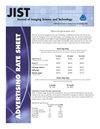基于矩阵r的最优颜色视觉响应及其在图像色域扩展中的应用
IF 0.5
4区 计算机科学
Q4 IMAGING SCIENCE & PHOTOGRAPHIC TECHNOLOGY
Journal of Imaging Science and Technology
Pub Date : 2023-09-01
DOI:10.2352/j.imagingsci.technol.2023.67.5.050414
引用次数: 0
摘要
在恒定亮度下具有最大色度的最佳颜色为追求最终宽色域的着色剂提供了理想的目标。MacAdam证明了最优颜色是由至少有两个转换波长λ1和λ2的正方形脉冲型光谱组成,其反射率从0到1或从1到0。最佳色域由两种类型创建,一种是反射率为1.0的凸型,在w = λ1 ∼λ2和0.0,或者w = λ1 ∼中反射率为0.0的凹型;λ2和1.0。高精度地搜索最优候选颜色并创建三维色域需要较高的计算成本。此外,人类视觉光谱对最佳颜色光谱的反应仍然是未知的。本文(1) 提出了一种利用GBD (Gamujt Boundary Descriptor)技术创建最优色域的简单替代方法;(2) 首次阐明了基于Matrix-R理论的人类视觉对最优颜色的光谱响应,这是迄今为止未知的;(3) 提出了以最优颜色为理想目标的质心不变的新型色域扩展方法,并将其应用于实际的低饱和度图像,验证了其效果。本文章由计算机程序翻译,如有差异,请以英文原文为准。
Matrix R-based Visual Response to Optimal Colors and Application to Image Color Gamut Expansion
The optimal colors with maximum chroma at constant lightness present an ideal target for the colorants pursuing the ultimate wide color gamut. MacAdam proved that optimal colors are composed of square pulse-shaped spectra with at least two tansition wavelengths λ1 and λ2 whose reflectances change from 0 to 1 or 1 to 0. The optimal color gamut is created from two-types, a convex-type with reflectance 1.0 in w = λ1 ∼ λ2 and 0.0 otherwise, or a concave-type with reflectance 0.0 in w = λ1 ∼ λ2 and 1.0 otherwise. It takes a high computation cost to search the optimal color candidates in high precision and to create the 3D color gamut. In addition, the human visual spectral responses to the optimal color spectra remain unknown. This paper (1) proposes an alternative simple method for creating the optimal color gamut with GBD (Gamujt Boundary Descriptor) technique, and (2) clarifies how human vision spectrally respond to the optimal colors based on Matrix-R theory, for the first time which was unknown until now, and (3) presents centroid-invariant novel color gamut expansion method considering the optimal color as an ideal target and finally apply it to actual low-saturation images to verify its effect.
求助全文
通过发布文献求助,成功后即可免费获取论文全文。
去求助
来源期刊

Journal of Imaging Science and Technology
工程技术-成像科学与照相技术
CiteScore
2.00
自引率
10.00%
发文量
45
审稿时长
>12 weeks
期刊介绍:
Typical issues include research papers and/or comprehensive reviews from a variety of topical areas. In the spirit of fostering constructive scientific dialog, the Journal accepts Letters to the Editor commenting on previously published articles. Periodically the Journal features a Special Section containing a group of related— usually invited—papers introduced by a Guest Editor. Imaging research topics that have coverage in JIST include:
Digital fabrication and biofabrication;
Digital printing technologies;
3D imaging: capture, display, and print;
Augmented and virtual reality systems;
Mobile imaging;
Computational and digital photography;
Machine vision and learning;
Data visualization and analysis;
Image and video quality evaluation;
Color image science;
Image archiving, permanence, and security;
Imaging applications including astronomy, medicine, sports, and autonomous vehicles.
 求助内容:
求助内容: 应助结果提醒方式:
应助结果提醒方式:


